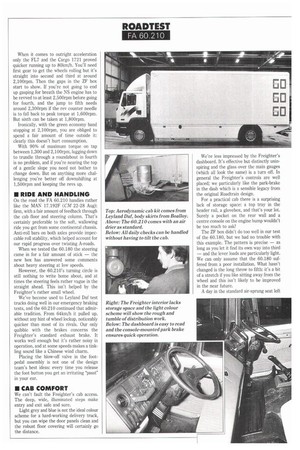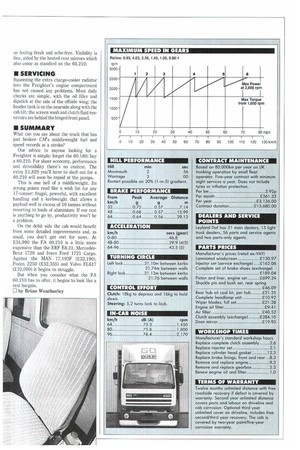ROADTEST
Page 34

Page 35

If you've noticed an error in this article please click here to report it so we can fix it.
FA 60 210
When it comes to outright acceleration only the FL7 and the Cargo 1721 proved quicker running up to 80knri/h. You'll need first gear to get the wheels rolling but it's straight into second and third at around 2,100rpm. Then the gaps in the ZF box start to show. If you're not going to end up gasping for breath the NS engine has to be revved to at least 2,500rpm before going for fourth, and the jump to fifth needs around 2,300rpm if the rev counter needle is to fall back to peak torque at 1,600rpm. But sixth can be taken at 1,800rpm.
Ironically, with the green economy band stopping at 2,100rpm, you are obliged to spend a fair amount of time outside it: clearly this doesn't hurt consumption.
With 90% of maximum torque on tap between 1,300 and 2,100rpm, lugging down to trundle through a roundabout in fourth is no problem, and if you're nearing the top of a gentle slope you need not bother to change down. But on anything more challenging you're better off downshifting at 1,500rpm and keeping the revs up.
• RIDE AND HANDLING
On the road the FA 60.210 handles rather like the MAN 17.192F (CM 22-28 Aug): firm, with a fair amount of feedback through the cab floor and steering column. That's certainly preferable to the soft, wallowing ride you get from some continental chassis. Anti-roll bars on both axles provide impeccable roll stability, which helped account for our rapid progress over twisting A-roads.
When we tested the 60.180 the steering came in for a fair amount of stick — the new box has answered some comments about heavy steering at low speeds.
However, the 60.210's turning circle is still nothing to write home about, and at times the steering feels rather vague in the straight ahead. This isn't helped by the Freighter's rather small wheel.
We've become used to Leyland Daf test trucks doing well in our emergency braking tests, and the 60.210 continued that admirable tradition. From 64km/h it pulled up, without any hint of wheel lockup, noticeably quicker than most of its rivals. Our only quibble with the brakes concerns the Freighter's standard exhaust brake. It works well enough but it's rather noisy in operation, and at some speeds makes a tinkling sound like a Chinese wind charm.
Placing the blow-off valve in the footpedal assembly is not one of the design team's best ideas: every time you release the foot button you get an irritating "psssr in your ear.
• CAB COMFORT
We can't fault the Freighter's cab access. The deep, wide, illuminated steps make entry and exit safe and sure.
Light grey and blue is not the ideal colour scheme for a hard-working delivery truck, but you can wipe the door panels clean and the robust floor covering will certainly go the distance. Top: Aerodynamic cab kit comes from Leyland Daf, body skirts from BoaBoy. Above: The 60.210 comes with an air drier as standard.
Below: All daily checks can be handled without having to tilt the cab.
Right: The Freighter interior lacks storage space and the light colour scheme will show the rough and tumble of distribution work.
Below: The dashboard is easy to read and the console-mounted park brake ensures quick operation. We're less impressed by the Freighter's dashboard. It's effective but distinctly uninspiring and the glass over the main gauges (which all look the same) is a turn off. In general the Freighter's controls are well placed; we particularly like the park-brake in the dash which is a sensible legacy from the original Roadtrain design.
For a practical cab there is a surprising lack of storage space: a top tray in the header rail, a glovebox, and that's your lot. Surely a pocket on the rear wall and a centre console on the engine hump wouldn't be too much to ask?
The ZF box didn't do too well in our test of the 60.180, but we had no trouble with this example. The pattern is precise — as long as you let it find its own way into third — and the lever loads are particularly light. We can only assume that the 60.180 suffered from a poor installation. What hasn't changed is the long throw to fifth: it's a bit of a stretch if you like sitting away from the wheel and this isn't likely to be improved in the near future.
A day in the standard air-sprung seat left us feeling fresh and ache-free. Visibility is fine, aided by the heated rear mirrors which also come as standard on the 60.210.
• SERVICING
Squeezing the extra charge-cooler radiator into the Freighter's engine compartment has not caused any problems. Most daily checks are simple, with the oil filler and dipstick at the side of the offside wing; the header tank is on the nearside along with the cab tilt: the screen wash and clutch fluid reservoirs are behind the hinged front panel.
• SUMMARY
What can you say about the truck that has just broken CM's middleweight fuel and speed records at a stroke?
Our advice to anyone looking for a Freighter is simple: forget the 60.180; buy a 60.210. For sheer economy, performance and driveability there's no contest. The extra £1,820 you'll have to shell out for a 60.210 will soon be repaid at the pumps.
This is one hell of a middleweight. Its strong points read like a wish list for any 17-tonner: frugal, powerful, with excellent handling and a kerbweight that allows a payload well in excess of 10 tonnes without resorting to loads of aluminium. If our test is anything to go by, productivity won't be a problem.
On the debit side the cab would benefit from some detailed improvements and, as usual, you don't get owt for nowt. At £34,990 the FA 60.210 is a little more expensive than the ERF E8.21, MercedesBenz 1720 and Iveco Ford 1721 Cargo. Against the MAN 17.192F (32,190), Foden 2250 (£32,355) and Volvo FL617 (£32,000) it begins to struggle.
But when you consider what the FA 60.210 has to offer, it begins to look like a real bargain.
by Brian Weatherley
















































































